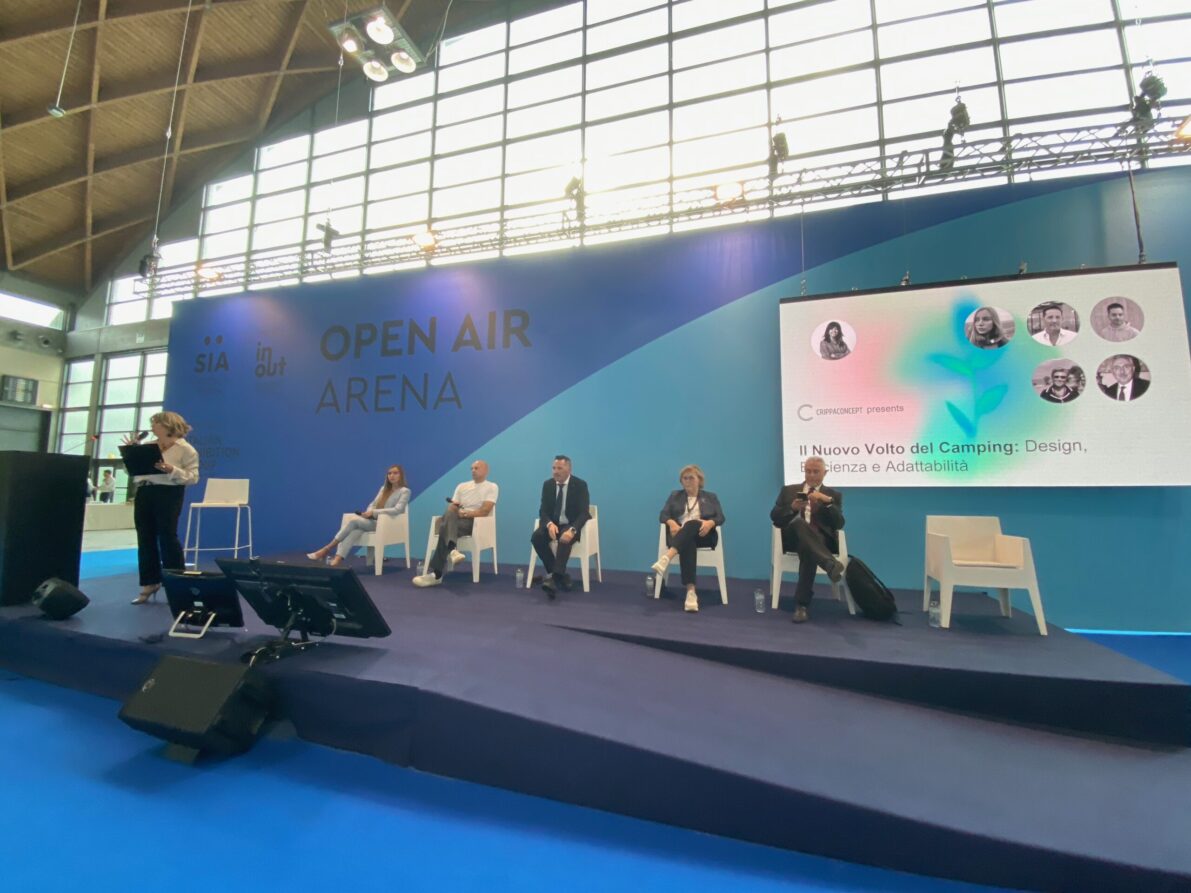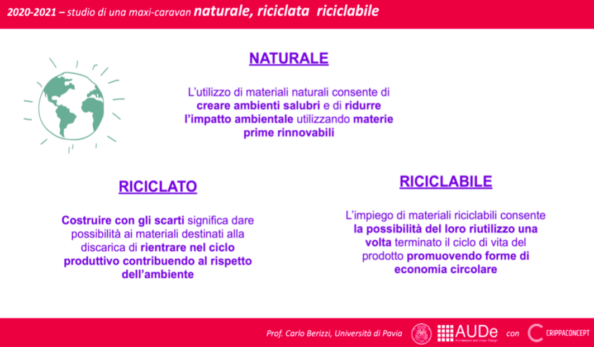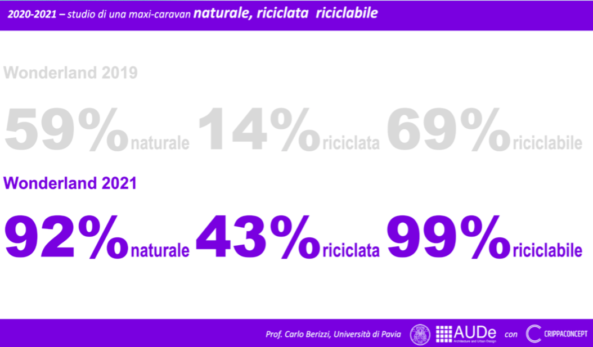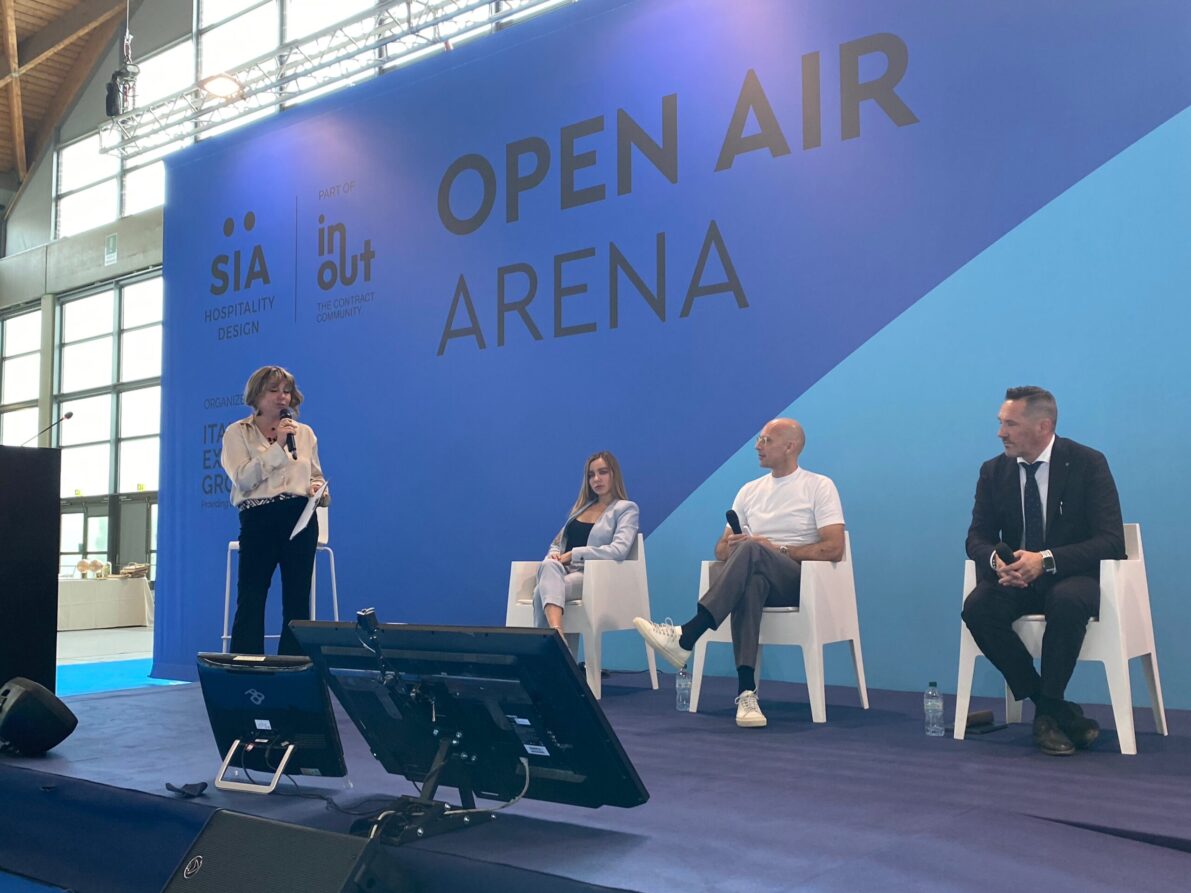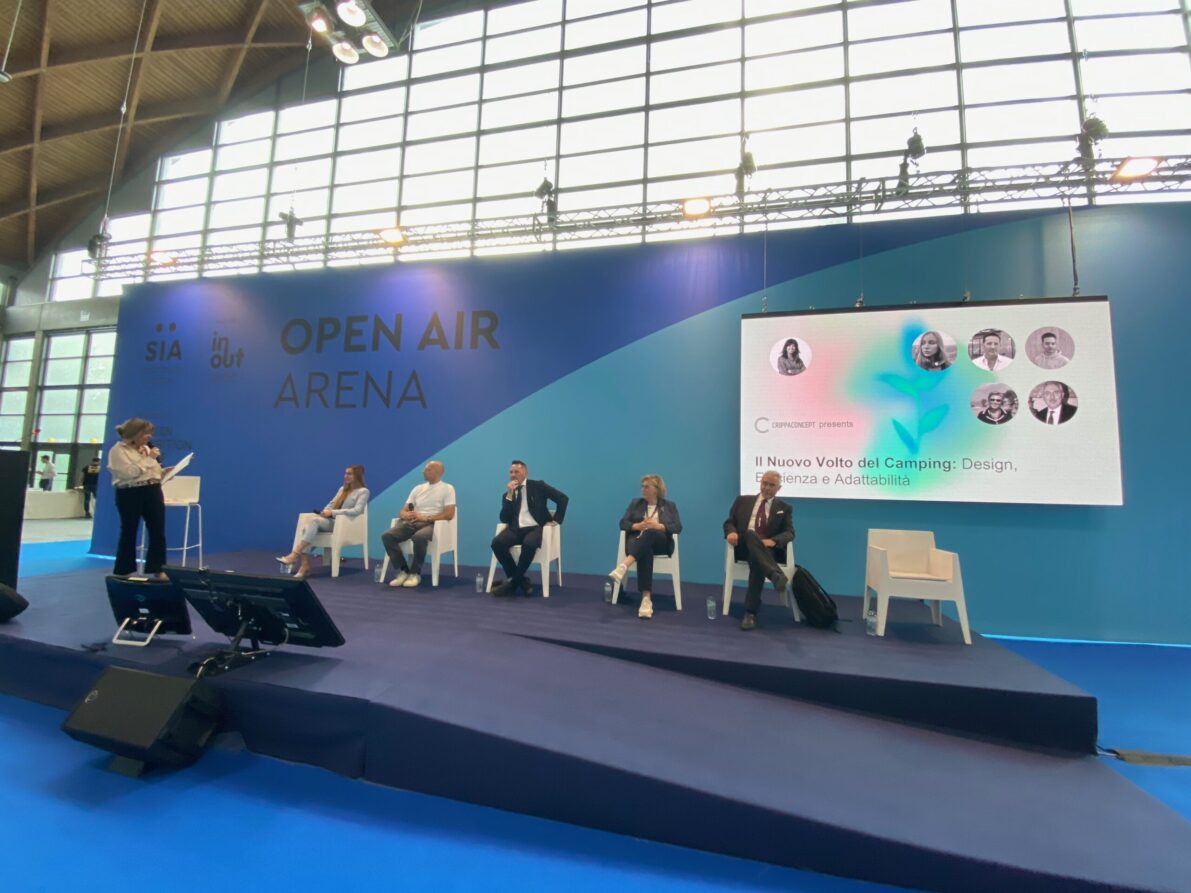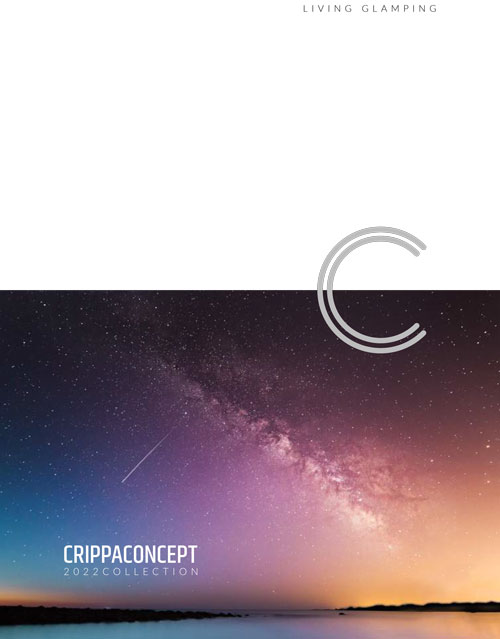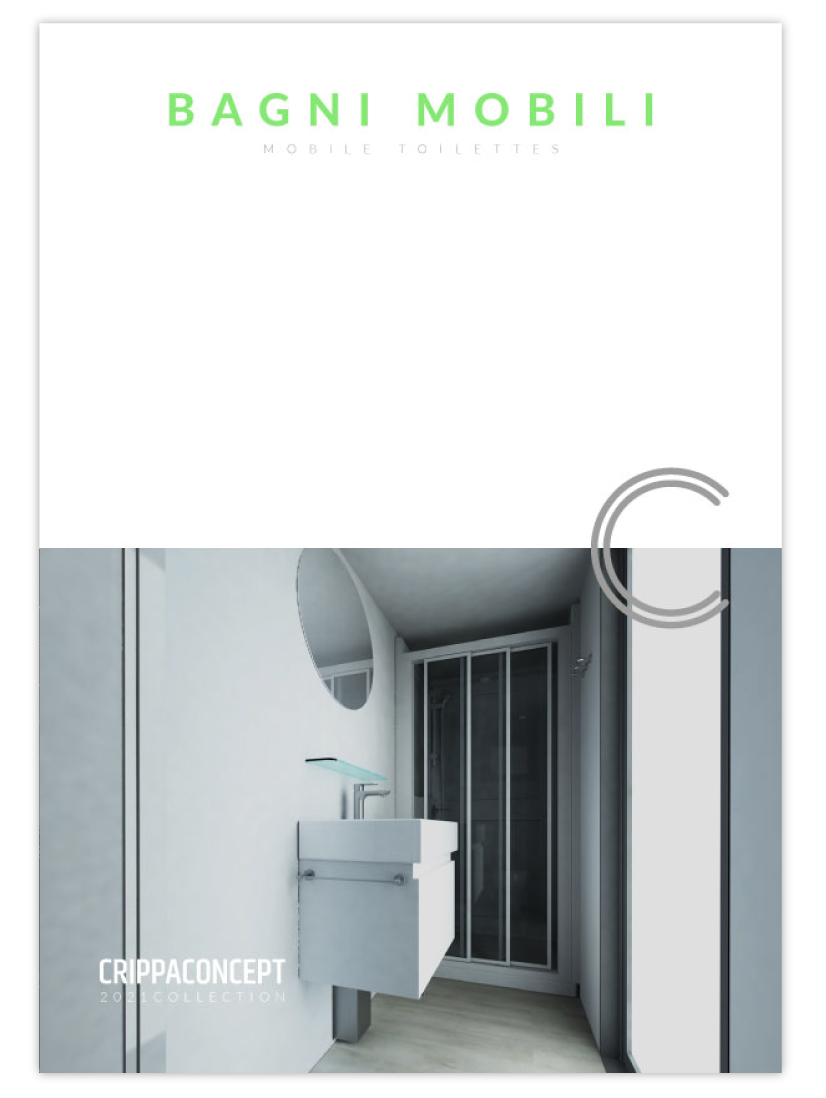During all the talks organised by Crippaconcept, the objective that drives the organisation of the line-up and the choice of speakers is one and the same: to provide food for thought and innovative ideas to open-air holiday operators. This was also the case on the occasion of “The New Face of Camping: Design, Efficiency and Adaptability”, the meeting that took place on 11 October in Rimini, on the occasion of SIA – TTG INOUT, a trade fair that brings together all the souls of the sector and at which Crippaconcept worked alongside FAITA _ Federcamping to set up the stand.
In front of a very interested audience, leading figures took turns, who, masterfully led by Maria Chiara Voci, a professional journalist for over fifteen years, author for Il Sole 24 Ore and passionate connoisseur of subjects related to construction and sustainability, provided information, data and very concrete problem-solving ideas for those who have to face the energy transaction of their accommodation facility, towards more conscious choices, but also for those who are faced with an uncomfortable situation following an unexpected weather event and for those who want to maximise their investment choices when replacing their equipment.
The times in depth, find out more:
• Crippaconcept Camping Design: what it is and what studies are underway
• Mobile Home Environmental Impact Self-Assessment
• Application of photovoltaic systems on mobile home roofs
• Resilience of Camping Villages to adverse weather events
• Long Term Rent Benefits in the Presence of Mobile Home Performance
Crippaconcept Camping Design: what it is and what studies are underway
The conference was opened by Margherita Capotorto, PhD student in Construction Engineering and Architecture at the University of Pavia. Her testimony was based on the numerous studies carried out at the University, in direct collaboration with Crippaconcept, which have led to the creation of the “Crippaconcept Camping Design” department, composed of a team of professionals who work alongside campsite owners to research morphological and landscape solutions suited to the area and specific needs, to improve the sustainability aspect, the general design and the impact on the surrounding environment, an objective that has been shown to be an increasing priority in the open-air holiday sector.
The study process begins with a reading of the site, which defines the constraints and potential of “doing”. On the basis of this, an outline master plan and some architectural suggestions are proposed. In a second phase of the process, we move on to applied research, choosing materials and the arrangement of vegetation, refining through to realisation. Numerous examples can already be recounted, one of them at the Camping Village La Rocca di Bardolino, which we have already discussed in detail here.
The research does not stop here, in fact the Aude laboratory of the University of Pavia is also focusing on the interior spaces of the mobile home in order to find increasingly optimal solutions in relation to accessibility and comfort. Starting by researching the minimum dimensions of the regulations, architectural references and the empirical experience of the researchers involved, three levels of comfort have been catalogued. This made it possible to understand when, if and where the space currently proposed in a mobile home meets the needs of the human body. The study then went on to analyse the space horizontally, but also vertically. In this way, it was possible to define a number of improvement solutions in which comfort, quality and accessibility are guaranteed.
Evidence of the intervention: Through academic study and entrepreneurial collaboration, it is currently possible to create master plans specifically designed for the different camping villages that take into account their specificities and that also integrate housing solutions created to maximise comfort and accessibility.
Mobile Home Environmental Impact Self-Assessment
Another very important step of research is the one related to the regulatory aspect and the definition of the mobile home ‘product’, on which Crippaconcept has activated numerous studies since 2019 when it was realised that there were no official documents related to this structure that has now become the fulcrum of open-air receptivity. In his speech, Sergio Redaelli, Crippaconcept’s administrator, retraced all the stages that led to a new awareness in the space of a few years. The first document produced was the book Mobile Home for Open Air Tourism. Storia evolutiva, which over the years has established itself as a useful handbook on both a technical and political level as the research was based on two foundations, one regulatory and one legislative. In the same year, a workshop in collaboration again with the University of Pavia led to the creation of Wonderland, which proposed the first master plan with 20 mobile homes designed specifically for the family. In 2021 Wonderland 2.0, the evolution towards the highest level from a point of view of natural, recycled and recyclable building materials. A study that has helped the entire company grow in this direction.
“This work has led us today,” Redaelli explained, “to create a real Voluntary Declaration of Environmental Sustainability, which we manufacturers provide in relation to the product made and which can also be attached to regional declarations or for any other specific request. A document that, at the moment, fills a regulatory gap at European level in which the mobile home is not present and therefore does not allow for official certification.
A path that is always evolving, but which has an important objective towards sustainability, not only to adapt to a general market trend, but to create value and accompany the customer, i.e. the camping village, towards also and above all the satisfaction of the end user, the one who chooses to take a holiday. “I always say that the owner of a campsite is nothing more than a guardian of a park,” concluded Sergio Redaelli, “and consequently, the inclusion of new products must be seen in a protective perspective, because inserting a correct product, in the most suitable way, in a natural context, helps to enhance the place first and foremost, and everyone, from the end user, to the camping village and the environment itself, will gain an advantage.
Evidence of the intervention: studying and researching towards the creation of products that are as natural, recycled and recyclable as possible is a priority objective for Crippaconcept, which can now also provide a Voluntary Declaration of Environmental Sustainability for its products. Above all, the aim is to work alongside campsite owners to enhance their environment.
Application of photovoltaic systems on mobile home roofs
The conference then focused on an extremely topical issue, that of energy supply, addressed by Cristiano Bozzetti, Crippaconcept’s marketing manager, standing in for engineer Salvatore Nitra, who was unable to attend. In particular, the result of a company study on the application of photovoltaic panels on the roofs of mobile homes was presented. The question asked was: how is it possible to strike a balance between energy independence and sustainability?
The roof of a mobile home can accommodate around 9 photovoltaic panels, with a maximum output of between 3 and 4 kW, considering an average daily production, which in summer is estimated to be around 40 KW, and a storage capacity of around 10 KW with battery. Consumption ranges from 20 KWh/day for a BASIC mobile home, to 20 KWh/day for a STANDARD mobile home that uses not only light but also air conditioning, up to 30 KWh/day for a FULL electric mobile home, powered by electricity for lighting, air conditioning, with two systems for air conditioning the rooms, an induction hob and an electric boiler. There will therefore be an excess of availability, which raises many questions as to what to do with it. At the same time one wonders what would happen on cloudy and cold days and in winter periods when the campsite is closed. Is it always and in any case advisable for the mobile home to be OFF-Grid, i.e. totally disconnected from the campsite system, or is it advisable to integrate it with the accommodation?
To understand this, economic evaluations are needed, which have been made on a hypothetical level. Each individual mobile home system can cost around 15,000 euros, considering 7,000 euros for the panels and 8,000 for the batteries, an investment whose return will be in 10 to 15 years. In addition to these two elements, it is necessary to have a technical compartment where the batteries and inverters can be stored, a provision for the passage of cables from the roof to the technical compartment, a roof capable of supporting the weight of the photovoltaic panels, which is already the case today, and it will also have to have, if it can, a bi-directional inverter, because if the battery goes into deficit and is unable to withstand a day of heavy cloudiness, it needs to access the grid. This leads to the assumption that there can be no complete disconnection, in any case, and that the best solution is to connect to the campsite’s system. This avoids the need for batteries and an ad hoc compartment, with a lower initial investment that could be estimated at 6,000 euro per mobile home, with a payback in five years. In this case, a suitable roof would still be needed to accommodate the panels and the passage of a cable, but nothing more. And, above all, the excess energy, produced on sunny days, could enter the system with the entire structure, redistributed to the campsite users even during the winter phase or exchanged with the operator. Thus the average life of the system (25 years) could exceed the average commercial life of the house (10 years) without replacement.
Evidence of the intervention: A photovoltaic system disconnected from the mobile home supplies it with energy and supplies the excess to the facility in addition to selling it to the operator and allows not having a metered storage system for each accommodation, just a technical room in the accommodation. This choice generates savings in the long run.
Resilience of Camping Villages to adverse weather events
One of the topical issues that was discussed in depth during the talk on 11 October was the impact that climate change is having on the serenity of camping villages, as sudden events can generate crisis situations that can create inconveniences that need to be managed quickly. Discussing this topic were Sergio Redaelli and Margherita Facchini, owner of the San Francesco Camping Village in Desenzano del Garda, hard hit at the end of July 2023 by a hailstorm that literally ‘destroyed everything’.
“Unfortunately, on 24 July 2023 at about 11 p.m., we were hit by a hailstorm we had never seen before,” explained Margherita Facchini, “which was devastating in all senses. First of all in an emotional sense and in terms of fear, because it was so heavy, with hailstones as big as oranges, that, with the campsite full, we feared there might also, unfortunately, be deaths, which fortunately did not happen. Several people were injured, but all rescued. And secondly, we had to deal with this emergency immediately from 11.10 p.m.: people with cars, caravans, destroyed tents, obviously very frightened. The town of Desenzano was also devastated by the hail and the civil protection was immediately activated. The mayor sent us a team that I immediately included in my first-aid organisation, which was more concerned with calming people down until 5am, when we took a damage assessment and set to work recovering everything. By 7.30am the Crippaconcept teams were already there at our side. We started, together, to organise all the maintenance and debris removal work. Out of 202 mobile homes in the camping village, only two had remained intact, the other 200 had all been affected. None with problems on the roofs, even if they were marked, and no seepage, favourable conditions that allowed the guests to continue their holiday serenely. However, all the walls were ruined, so the cleaning teams had to collect glass, plastic, everything, and with Crippaconcept we immediately planned the safety measures and actions to be taken to enable us to make it to the end of the season. The idea they came up with was exceptional,’ continues Facchini, ‘even from an aesthetic point of view. In fact, a special sheet was used to cover the entire mobile home (wrapping), which made it aesthetically pleasing in a very short time. For this, I would like to thank Sergio and all, really all the workers who were close to me at that time, our company did not stop for a moment. All the services, thanks to them, kept going. Even on a human level, I found so much support.”
“The topic of rapid intervention following an adverse weather event is one in which we are directly involved as Crippaconcept,” confirms Redaelli, “given the importance of mobile homes within tourist facilities. What we want to do, precisely to support them on these occasions, is to be a true partner, aware that the most important job will be for the accommodation facility to ensure that guests can continue their holiday in peace. We must help them in this task of preparing the campsite to welcome even those guests who have not experienced the event directly and therefore cannot understand what has happened, but expect to have a pleasant holiday. This is why our drive, right from the start, is to intervene as quickly as possible to restore all the furniture, repairing and adapting it so that we can move forward, putting the weather event behind us until the end of the season. We always have our own operational organisation, the company never closes and above all is reinforced in the assistance part when the campsites are open and at full capacity, i.e. in the summer period, precisely so that we can really intervene in real time.”
Evidence of the intervention: climate change puts accommodation facilities at risk. At any moment, they may find themselves in a serious situation, in which to quickly implement all useful actions to restore the camping village in an appropriate way so that guests can continue their holiday peacefully. Crippaconcept is at the entrepreneurs’ side right from the start for this purpose, providing support and solutions that are not only functional but also aesthetically satisfying.
Long Term Rent Benefits in the Presence of Mobile Home Performance
The last topic addressed at the conference entitled “The New Face of Camping: Design, Efficiency and Adaptability” organised by Crippaconcept during SIA – TTG INOUT was that of Long Term Rent, proposed by Mauro Federzoni, Chairman of the Board of Directors of Intesa Sanpaolo Rent for You, who had already talked about this important opportunity for all owners of accommodation facilities in the past.
Operational rental is a commercial service offered to all customers of Banca Intesa Sanpaolo, which allows them to enjoy the use of goods and services, thanks to the payment of a single periodic fee, structured and planned on the needs of the applicant. The pluses are several:
- Spending certainty and tax advantages
There is certainty of expenditure, with a fixed fee that is not affected by adjustments, has no worsening of the financial position and enjoys tax advantages.
- No purchase constraints
You can use the capital goods useful for your business without having to purchase them and without having to commit to credit lines and reporting to the risk centre.
- Assets in step with the times
You have access, for the duration of the contract, to capital goods in line with the latest technology available on the market (without any risk of obsolescence).
“Rental is a commercial service,” Federzoni explains, “not a financial service. We purchase the goods from Carippacampeggio Srl and give them to the accommodation facilities so that they can be used and exploited. The rental fee can be 100% deducted from taxes for the duration of the contract, which for mobile homes is usually five to seven years. No provisions need to be made because the asset is put on the bank’s books. And the instalments on maturity do not go to the risk centre, because we are not a commercial company. The field remains free for creditworthiness, for overdrafts and everything else that is needed for the business.”
From 1 October, special treatment will also be given to Crippaconcept customers to accompany new investments and replacements of existing structures:
- A confidential investigation process
- Favourable conditions in terms of duration and pricing
Hiring can also take place on other types of capital goods such as photovoltaic panels.
Evidence of the intervention: users of long-term hire can benefit from tax advantages, no purchase obligation and state-of-the-art assets. Operational leasing raises awareness of short-, medium- and long-term development strategies. It does not affect cash flow, does not preclude access to credit and contributes to the spread of the circular economy.
The event concluded with thanks from Maria Chiara Voci to all the speakers who brought their interesting contributions to the stage. We join in this thanks and extend it also to Maria Chiara, who is always attentive to the topics that are close to our hearts and able with great skill to lead such an important and useful moment of in-depth discussion.

